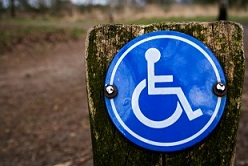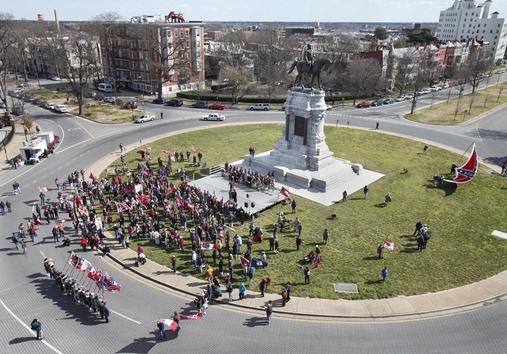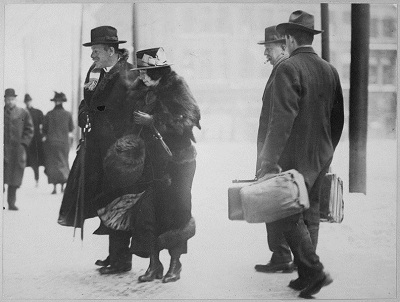Back in business...
 This weekend I dusted off our wheelchair equipment in anticipation of this year’s upcoming tourist season. Since AABT’s launch last year, we have received great support from both the local tourist and national wheelchair-traveler communities. Our inaugural trips were a surprising success and it seemed like we were just getting started before the season turned cold. Much like the soldier’s whose footsteps we follow, we too went into winter quarters. I was able to give several walking tours during the off-season and this enabled me to identify some new areas that I had not considered before. As a result, AABT has expanded our tour of the Fredericksburg Battlefield to include an extended hike on the Slaughter Pen Farm. Tours begin booking again in April.
This weekend I dusted off our wheelchair equipment in anticipation of this year’s upcoming tourist season. Since AABT’s launch last year, we have received great support from both the local tourist and national wheelchair-traveler communities. Our inaugural trips were a surprising success and it seemed like we were just getting started before the season turned cold. Much like the soldier’s whose footsteps we follow, we too went into winter quarters. I was able to give several walking tours during the off-season and this enabled me to identify some new areas that I had not considered before. As a result, AABT has expanded our tour of the Fredericksburg Battlefield to include an extended hike on the Slaughter Pen Farm. Tours begin booking again in April.
My goal this year is to get some special programs going with organizations such as the Wounded Warriors Project and Disabled Veterans of America. Nothing gives me more satisfaction that helping to provide folks with a specially-paced and safely-maneuverable tour of our area’s hallowed grounds. It is a real privilege for me to do that and I cannot wait to begin again. I am really looking forward to working with my fellow AABT guides Mark Jones and John Cummings.
I just can't believe we were standing on hallowed ground and the both of you so invaluable in bringing it all back to life----chills!! We are truly thankful to you and John and the amazing work you both are doing to keep history alive, thank you. With much thanksgiving. - Mike & Irene Breshears, OR
If you’re new to All-Access Battlefield Tours, here’s a brief background on us: AABT is a private tour service designed especially for wheelchair travelers who wish to fully explore and experience the hallowed grounds of Fredericksburg and Spotsylvania, VA. AABT’s all‐accessible individual or group tours take visitors, their families and friends directly to historical hotspots while moving at their own pace. In order to provide a safe and comfortable expedition, visitors have the option of being transferred to customized travel wheelchairs that feature special wheels and canopies. These rugged outdoor chairs, combined with portable ramps, enable visitors to traverse fields, trails and roads that are otherwise inaccessible. Each experience includes complete accessibility assistance and the highest quality tours, featuring a unique staff of experts made up of local historians, authors and preservationists. For more information, please visit our website.
Please spread the word to anyone who may be interested in our services. We are a small, locally owned and operated business who needs all of the promotion that we can get. Thanks!
2012 Events (w/ more to come)
March 19: Speaking engagement: Civil War Forum Series, ‘The Great Revival at St. George’s Episcopal Church’ (Fredericksburg)
March-May: (2) New Mort Kunstler print copy released by American Spirit Publishing
April: The Civil War in Spotsylvania County eBook released by The History Press
May: You Stink! Major League Baseball’s Terrible Teams and Pathetic Players book released by The Kent State University Press
May 8: Speaking engagement: Richmond Civil War Roundtable, ‘Campfires at the Crossroads’ (Richmond)
May-June: ‘Exploring the Sexuality of a Founding Father,’ Alexander Hamilton article in Gay and Lesbian Review Worldwide
Sept. 28-30: (*tentative): Film screening, ‘The Angel of Marye's Heights,’ Liberty University 16th Annual Civil War Seminar (Lynchburg)
Nov 17: Book signing, Civil War Authors Day, Gray Ghost Vineyards (Amisville)
Nov-Dec: ‘Checkmate,’ Colonel Johann Gottlieb Rall article in Patriots of the American Revolution magazine
*Also, it’s time to start booking your 2012 AABT battlefield tours. We have some great programs put together for this year’s packages.
And they wonder why people have a hard time taking them seriously…

Last week's Confederate rally on Monument Avenue in Richmond
With chants of "God save the South," Civil War re-enactors marched down Monument Avenue on Saturday for a Southern pride rally at the Robert E. Lee statue. Battle flags rustled in blustering winds as Sons of Confederate Veterans color guard units representing more than a dozen states paraded in formation. One unit chanted: "What do we do? Kill Yankees! How many? All of them!" It was a decidedly different tone from the inclusive nature of official commemorations of the 150th anniversary of the Civil War. A small plane with a banner reading "Richmond, Embrace Your Confederate History" circled the gathering as speakers denounced Abraham Lincoln and praised Lee and Jefferson Davis. - Richmond Times Dispatch
History on the Home Front
Here's a piece that I originally submitted for one of our publications here at the U.S. Marshals Service. It didn't quite fit the overall theme of the issue so I am sharing it here instead...

Ernst Kunwald in the custody of two U.S. Marshals, 1917
Once called “The Great War,” what we refer to today as World War 1 (WWI) has become a frequently overlooked conflict in the annals of American history. This major military action centered in Europe, beginning on July 28, 1914 and lasting until November 11, 1918. Much like its successor, WWI also assembled two opposing coalitions made up of the world’s largest superpowers: the Allies, including the United Kingdom, France, and Russia; versus the Central Alliance, made up of Germany, Austria-Hungary and Italy.
The United States entered the conflict in support of the Allies when President Woodrow Wilson issued a declaration of war against Germany on April 6, 1917. For the next 19 months the United States Marshals Service acted as a home front guardian while protecting the nation against the threat of enemy spies and saboteurs.
Much like today, U.S. Marshals worked closely with local law-enforcement officers while taking precautions against hostile acts. This included keeping a careful watch over German aliens who may have remained loyal to their homeland. U.S. Marshals were instrumental in the location and seizure of illegal weapons, explosives and radios that were harbored by enemy sympathizers. The agency also assisted with the preservation of the draft. This included the protection of Selective Service centers and the apprehension of draft evaders or those disrupting the draft process.
Securing America’s entryways and infrastructure was an essential duty during WWI. The U.S. Marshals provided security by maintaining restricted zones around shipping docks, steel factories, military bases and arsenals. They also enforced the government’s pass procedures that required German aliens to carry specially issued identification. In doing so, the United States Marshals Service was given the sole authority to arrest and detain enemy aliens.
This period witnessed one of the first attempted acts of domestic terrorism on America's infrastructure. On February 2, 1915 an attempt to bomb the Vanceboro International Bridge, connecting the Canadian province of New Brunswick to Maine, was conducted by a German agent named Werner Van Horne. The attack was masterminded by then spymaster Franz von Papen who later served as Chancellor of Germany in 1932 and as Vice-Chancellor under Adolf Hitler in 1933–1934.
Prior to conducting the mission it is said that Van Horne changed into a German army uniform to avoid being convicted of being a spy and executed. He then proceeded to the railway bridge over the St. Croix River with a suitcase of explosives. What happened next is chronicled in J.G. Bruce’s study of the incident titled “The History of McAdam 1871–1977:”
Horn proceeded to position a suitcase filled with explosives on the Canadian side of the bridge but was interrupted by an oncoming train and was forced to move out of its path. After he was sure it had passed he proceeded to reposition the explosives. However he was interrupted a second time by another train. Puzzled and not wanting to kill anyone, he waited until 1:07 a.m. on February 2 before again repositioning the bomb on a girder. Horn cut the fuse, this changed the time before the explosion from fifty minutes to only three. Horn lit the fuse with a cigar and somehow made it back to the Exchange Hotel through a gale in −30 °F temperature before the dynamite exploded. At 1:10 a.m. on Tuesday, February 2, 1915 the bomb exploded, blowing out windows across Vanceboro and St. Croix and exposing residents to the freezing air outside. Some iron beams on the bridge were twisted or bent but the damage was relatively minor.
Ironically, at least three Vanceboro residents had previously reported Van Horne’s suspicious behavior to the local U.S. immigration inspector who interviewed the German native at the hotel he was staying at. Van Horne calmly assured the examiner that he was merely a Danish farmer looking to purchase land in the area. The local sheriff for Vanceboro, along with two Canadian police officers who crossed the border to provide assistance, later detained Horn back at the hotel. He was interrogated by the Federal Bureau of Investigation for several days and signed a confession with an agreed-upon statement of facts where he revealed the details of his crime.
Van Horne was transferred over to the custody of the U.S. Marshals and led before a federal grand jury in Boston, Massachusetts at the United States District Court. He was indicted on March 2, 1915 for his most serious crime while in the United States, a charge of transporting explosives on a common carrier that also transported passengers for hire. His sentence was to serve 18 months at the Atlanta Federal Penitentiary in Georgia which he completed before being extradited to Canada in October of 1919, retried and sentenced to serve an additional 10 years at Dorchester Penitentiary in New Brunswick. Van Horne’s mental capacity soon deteriorated and he was judged to be insane in July of 1921 whereby he was released and deported back to Germany.
Unfortunately not all suspected aliens who ended up in U.S. Marshal’s custody were as guilty as Werner Van Horne. Such was the story of Ernst Kunwald, a gifted Austrian conductor who served as assistant conductor of the Berlin Philharmonic and was the conductor of the Cincinnati Symphony Orchestra and the Cincinnati May Festival. As an outbreak of paranoia and prejudice swept the nation many Germans were mistakenly identified as enemies of the state. In November of 1917, the Daughters of the American Revolution used their civic influence to instigate the forbiddance of a Kunwald symphony in Pittsburgh. Rumors quickly circulated challenging the conductor’s loyalties.
Kunwald was arrested in December of that year by the United States Marshals Service who released him from jail the very next day. One month later he was interned under the Alien Enemies Act and imprisoned at Fort Oglethorpe in Georgia. Fellow conductor Karl Muck later joined him lending credence to the theory that their unjust imprisonment was due to their spread of German music which may have been considered overly propagandistic. According to a memo drafted by J. Edgar Hoover, Kunwald had conducted the Star-Spangled Banner before one concert after telling the orchestra and audience (many of whom were German) that his sympathies were with his own country. Hoover’s claim was never substantiated.
By the end of the war the Central Alliance had been militarily and politically defeated and ceased to exist. The League of Nations was formed in the hope of preventing another such conflict although the European nationalism spawned by the war and the breakup of empires are generally agreed to be factors contributing to World War II. As America’s troops returned from the muddy trenches of the western front, the U.S. Marshals maintained their mission until Armistice was declared in November of 1918. The following month all restrictions were lifted and federal law enforcement agencies returned to business as usual.
At the outset of war President Wilson told the American public that “We must all speak, act, and serve together.” There is no question that the United States Marshals Service met that directive with distinction. Over the course of the nation’s participation in WWI the agency investigated 222,768 violations of the selective service laws; registered 480,000 German enemy aliens; issued 200,000 permits to enemy aliens; arrested 6,300 enemy aliens under Presidential Arrest Warrants; and interviewed 2,300 enemy aliens in military camps.
BONUS: For a timeline of significant USMS contributions during WWI, visit The U.S. Marshals during World War I: Protection of the Home Front webpage.
Sources:
History - The U.S. Marshals during World War I: Protection of the Home Front
German Spy Who Tried to Dynamite Bridge to Be Deported". The New York Times. July 23, 1921
Bruce, J. G. (1979). The History of McAdam 1871–1977 (Vanceboro Bridge. Pages 149–150). McAdam: McAdam Senior Citizens Historical and Recreational Club.
Cincinnati Symphony Leader, an Austrian, Rearrested on Washington Orders. New York Times. January 13, 1918
 This weekend I dusted off our wheelchair equipment in anticipation of this year’s upcoming tourist season. Since AABT’s launch last year, we have received great support from both the local tourist and national wheelchair-traveler communities. Our inaugural trips were a surprising success and it seemed like we were just getting started before the season turned cold. Much like the soldier’s whose footsteps we follow, we too went into winter quarters. I was able to give several walking tours during the off-season and this enabled me to identify some new areas that I had not considered before. As a result, AABT has expanded our tour of the Fredericksburg Battlefield to include an extended hike on the Slaughter Pen Farm. Tours begin booking again in April.
This weekend I dusted off our wheelchair equipment in anticipation of this year’s upcoming tourist season. Since AABT’s launch last year, we have received great support from both the local tourist and national wheelchair-traveler communities. Our inaugural trips were a surprising success and it seemed like we were just getting started before the season turned cold. Much like the soldier’s whose footsteps we follow, we too went into winter quarters. I was able to give several walking tours during the off-season and this enabled me to identify some new areas that I had not considered before. As a result, AABT has expanded our tour of the Fredericksburg Battlefield to include an extended hike on the Slaughter Pen Farm. Tours begin booking again in April.






